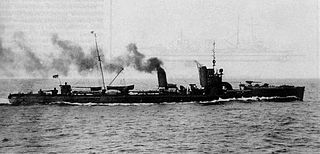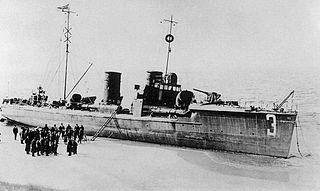SMS V1 was a V1-class torpedo boat of the Imperial German Navy. The ship was built by AG Vulcan, completing in 1912. She served in the First World War with the German High Seas Fleet, taking part in the Battle of the Heligoland Bight in 1914 and the Battle of Jutland in 1916. She was retained by the post-war German Navy and was stricken in 1929 and scrapped.
SMS G194 was a S-138-class large torpedo boat of the Imperial German Navy. She was built by the Germaniawerft shipyard at Kiel between 1910 and 1911, and was launched on 25 May 1911, entering service later that year. She served throughout the First World War, taking part in the Battle of Heligoland Bight on 28 August 1914. She was rammed and sunk by the British light cruiser Cleopatra on 26 March 1916.

SMS V189 was a S-138-class large torpedo boat of the Imperial German Navy. She was built by the AG Vulcan shipyard at Stettin between 1910 and 1911 and launched on 14 March 1911.

SMS V187 was a S-138-class large torpedo boat of the Imperial German Navy. She was built by the AG Vulcan shipyard at Stettin between 1910 and 1911 and launched on 11 January 1911.
SMS V188 was a S-138-class large torpedo boat of the Imperial German Navy. She was built by the AG Vulcan shipyard at Stettin between 1910 and 1911 and launched on 8 February 1911.

SMS V190 was a S-138-class large torpedo boat of the Imperial German Navy. She was built by the AG Vulcan shipyard at Stettin between 1910 and 1911, completing on 5 August 1911.

SMS V191 was a S-138-class large torpedo boat of the Imperial German Navy. She was built by the AG Vulcan shipyard at Stettin between 1910 and 1911 and launched on 2 June 1911.

SMS G7 was a V1-class large torpedo boat of the Imperial German Navy. She was built by the Germaniawerft shipyard at Kiel between 1911 and 1912, completing on 30 April 1912.
SMS G197 was a S-138-class large torpedo boat of the Imperial German Navy. She was built by the Germaniawerft shipyard at Kiel between 1910 and 1911, and was launched on 23 June 1911, entering service later that year.

SMS V2 was a V1-class torpedo boat of the Imperial German Navy. The ship was built by AG Vulcan, completing in 1912. She served in the First World War with the German High Seas Fleet, taking part in the Battle of the Heligoland Bight in 1914 and the Battle of Jutland in 1916. She was retained by the post-war German Navy and was stricken in 1929 and scrapped.
SMS S13 was a V1-class torpedo boat of the Imperial German Navy. The ship was built by Schichau-Werke, at their Elbing shipyard, completing in 1912. She served in the First World War with the German High Seas Fleet, taking part in the Battle of the Heligoland Bight in 1914. She was sunk by an accidental explosion on 6 November 1914.

SMS V3 was a V1-class torpedo boat of the Imperial German Navy. The ship was built by AG Vulcan, completing in 1912. She served in the First World War with the German High Seas Fleet, taking part in the Battle of the Heligoland Bight in 1914 and the Battle of Jutland in 1916. She was retained by the post-war German Navy and was stricken in 1929 and scrapped.
SMS V5 was a V1-class torpedo boat of the Imperial German Navy. The ship was built by AG Vulcan, completing in 1913. She served in the First World War with the German High Seas Fleet, taking part in the Battle of the Heligoland Bight in 1914, the Battle of Dogger Bank in 1915 and the Battle of Jutland in 1916. She was retained by the post-war German Navy and was stricken in 1929 and scrapped.

SMS V6 was a V1-class torpedo boat of the Imperial German Navy. The ship was built by AG Vulcan, completing in 1913. She served in the First World War with the German High Seas Fleet, taking part in the Battle of Jutland. After the war, she served with the Weimar Republic's Reichsmarine until stricken in 1929 and was subsequently broken up.
SMS G8 was a V1-class large torpedo boat of the Imperial German Navy. She was built by the Germaniawerft shipyard at Kiel between 1911 and 1912, completing on 6 August 1912.
SMS G9 was a V1-class large torpedo boat of the Imperial German Navy. She was built by the Germaniawerft shipyard at Kiel between 1911 and 1912, completing on 25 September 1912.
SMS G10 was a V1-class large torpedo boat of the Imperial German Navy. She was built by the Germaniawerft shipyard at Kiel between 1911 and 1912, completing on 28 August 1912.
SMS G11 was a V1-class large torpedo boat of the Imperial German Navy. She was built by the Germaniawerft shipyard at Kiel between 1911 and 1912, completing on 8 August 1912.
SMS G12 was a V1-class large torpedo boat of the Imperial German Navy. She was built by the Germaniawerft shipyard at Kiel between 1911 and 1912.
SMS G193 was a S-138-class large torpedo boat of the Imperial German Navy. She was built by the Germaniawerft shipyard at Kiel between 1910 and 1911, and was launched on 10 December 1910, entering service in 1911.








